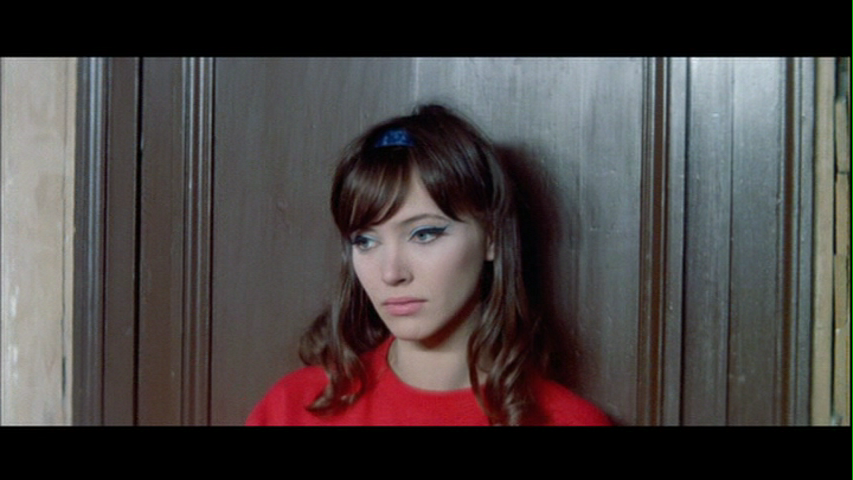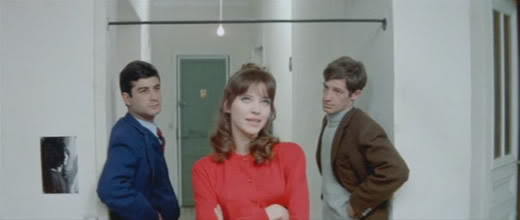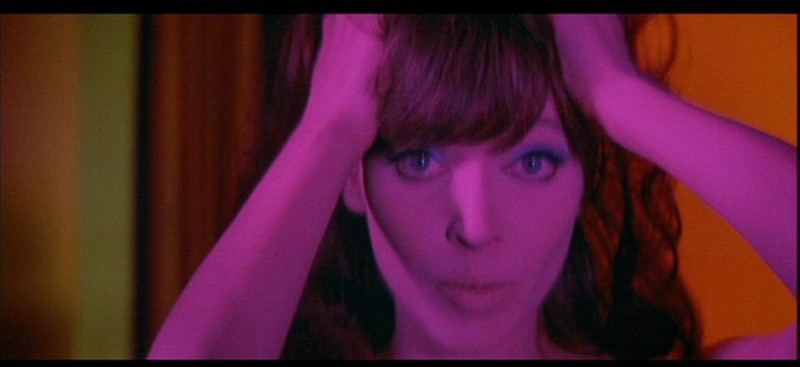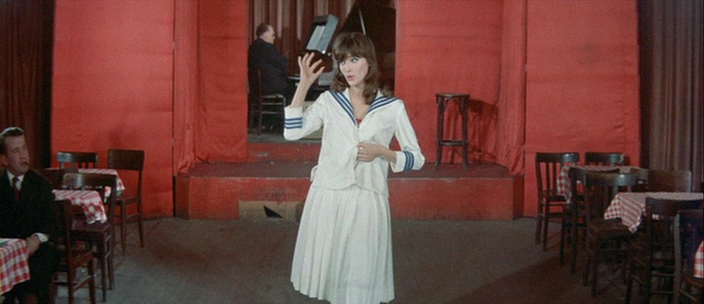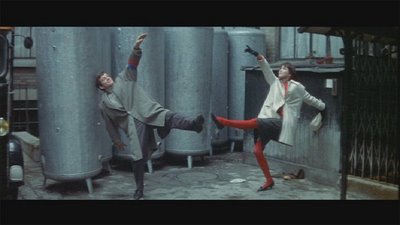From the Chicago Reader, July 25, 2003. Having just reseen Coppola’s One From the Heart (1982) for the first time since it came out, I experienced a similar ambivalence to this subsequent anti-musical, for related reasons. — J.R.
A Woman Is a Woman
** (Worth seeing)
Directed and written by Jean-Luc Godard
With Anna Karina, Jean-Claude Brialy, Jean-Paul Belmondo, and Marie Dubois.
Even after 40 years I’m still not sure how I feel about A Woman Is a Woman (1961), Jean-Luc Godard’s third feature. The first time I saw it, as a college junior in New York, it was an unmitigated delight. But that had a lot to do with its arrival at a time when it seemed to validate ideas I and other cinephiles had about French and American film culture. It was the fourth Godard feature to open in New York (after Breathless, Vivre sa vie, and Contempt, his first, fourth, and sixth films), and the second in color and ‘Scope (after Contempt). The very notion of someone subverting the way big-budget Hollywood used canvas and palette while also taking pleasure in those elements carried an enormous charge (Contempt had been a bit too close to big-budget Hollywood to look like subversion). But the most recent time I saw it — the umpteenth time — was at a Chicago press screening, and it was one irritation after another. The historical resonance was entirely different.
All my other viewings had fallen somewhere between these two extremes, though not in a steady descent. This is in part because of the film’s peculiar relation to American musicals. Godard conceived of it as a “neorealist musical,” which he conceded was a deliberate contradiction in terms. Technically it isn’t a musical at all. Yet it alludes to musicals at every turn, so it doesn’t fit snugly into any “nonmusical” category either.
Diabolically deconstructionist, A Woman Is a Woman comes close to being a Pavlovian experiment, provoking our desire to see a musical, yet failing to provide us with one. Portions of the dialogue are punctuated by musical exclamations and flurries, and characters are shown briefly striking poses that suggest a desire to be in a musical. But when Anna Karina, the star, performs her one song, in a seedy nightclub, Godard keeps her voice weirdly a cappella and alternates her lyrics with standard piano fills. Moreover, the singularity that once made the film intriguing is now gone, given all the subsequent French hommages to American musicals, including Godard’s own Pierrot le fou, Jacques Demy’s The Young Girls of Rochefort, Chantal Akerman’s The Golden Eighties and Window Shopping, and Jacques Rivette’s Up Down Fragile — all less theoretical by virtue of offering enjoyable and more conventional musical numbers.
The dopey plot of A Woman Is a Woman concerns Angela (Karina), a stripper in Strasbourg-Saint-Denis who’s determined to have a baby with her lover and flatmate, Emile (Jean-Claude Brialy), who doesn’t want to be rushed into it. After extended spats and a Godardian duel of words using book titles they silently flash at each other like accusations, Emile goes out on a date with another woman, then visits a prostitute. Angela winds up sleeping with her and Emile’s friend Alfred (Jean-Paul Belmondo), who’s plainly smitten with her. Eventually the couple make up and go to bed.
The film was made shortly after Godard married Karina, and his infatuation with her is apparent throughout. So is the sexist condescension. By implication, one reason he finds both her and her character — often viewed as interchangeable — so adorable, apart from her Danish accent, is that she’s an imbecile. In the pages of Cahiers du Cinéma André S. Labarthe praised the film when it came out as a documentary about Karina the person (as opposed to Karina the actress); he thought Godard’s inclusion of an “outtake” of her blowing a line made it even better. In the early 60s the very notion of rendering a commercial film personal and diaristic in this manner was revolutionary. (Later, in his monumental Out 1, Rivette would expand on the notion that anything an actor did was interesting — good or bad acting be damned — making something more metaphysical and less autobiographical out of it.) This remains a radical premise, though the Calvinist manner in which Godard strips his wife emotionally while keeping her clothed throughout, even though she’s playing a stripper, exposes things about his gender politics that today look rather conservative.
Citing a statement by Charlie Chaplin that tragedy is life in close-ups and comedy is life in long shots — which may be an apocryphal statement; I’ve never been able to track down a source — Godard spoke of his desire to explore another deliberate contradiction in A Woman Is a Woman by making a comedy in close-ups. He added that Jet Pilot — produced by Howard Hughes, directed by Josef von Sternberg, and no less sexist or stylistically freakish — also fell into that category. As if to underline this aspiration, Godard has Emile remark at least twice that he doesn’t know if what’s going on is a comedy or a tragedy, and once he adds, “In any case, it’s a masterpiece.” Yet whatever virtues A Woman Is a Woman can claim for itself, a refusal to conform to any notion of a masterpiece has to be one of them. Even Godard, when he called the film his personal favorite a short time after its release, explained that one always prefers the sick child to the healthy one, citing Otto Preminger’s alleged preference for The Fan as a model.
That Godard remained a film critic as well as something of a film theorist when he became a director made this early feature both a gift to and a challenge for cinephiles — a validation of some of our convictions and a test of others. This is already apparent in the colorful titles flashed on the screen at the beginning — over the sounds of Michel Legrand’s orchestra tuning up — which mix credits and allusive critical terms and references with jazzy abandon: “Once upon/a time/Beauregard/ Eastmancolor/Ponti/Fran Chement Scope/Godard/French/Comedy/Coutard/ Musical/Legrand/Theatrical/Evein/Sentimental/Guillemot/Opera/Lubitsch/July 14/Cinema.” After Karina declares offscreen, in English, “Lights! Camera! Action!” we get “Brialy/Karina/Belmondo/A Woman Is a Woman.”
Then as now a cult director, Godard was offering a code to initiates, some of whom could be trusted to know that Georges de Beauregard and Carlo Ponti were the producers, Raoul Coutard the cinematographer, Bernard Evein the production designer, and Agnès Guillemot the editor. Others might figure out that this theatrical and sentimental French comedy had traces of the musical and of opera, and that both director Ernst Lubitsch and René Clair’s Quatorze juillet (1933) were significant influences. Still others might be left out in the cold: I assume “Fran Chement Scope” is a pun involving the film’s anamorphic screen format (Franscope), and franchement (frankly), but why Godard considered this pun worth making is as unclear to me now as it was in December 1964. (The pun in the closing dialogue, only vaguely approximated in the subtitles, is a bit more justifiable, especially because it leads back to the film’s title. “Angela, tu es infame.” “Moi? Je ne suis pas infame. Je suis une femme.” (Literally, “Angela, you’re unspeakable.” “Me? I’m not unspeakable. I’m a woman.“)
The film was released soon after the initial successes of Francois Truffaut’s The 400 Blows and Godard’s Breathless, when these formerly marginalized critics were starting to feel their oats — even though Truffaut’s second feature, Shoot the Piano Player, had already flopped at the box office and Godard’s second, Le petit soldat, had been banned by French censors for its treatment of the Algerian war (which led Cahiers du Cinéma to publish all the film’s dialogue in serial form). A Woman Is a Woman is in some ways the cheekiest of Godard’s early features, with brazen plugs for Breathless, Shoot the Piano Player, and Truffaut’s Jules and Jim, then still in production. But it also came at an ambiguous point in Godard’s career, when it wasn’t clear whether he was going to turn commercial or become more esoteric. This film shows signs of both possibilities. It’s the only one of his early films shot, at least partly, in a studio, and it has a more conventional plot than anything he’s made since. But it also contains more aggressive assaults on commercial conventions than either of his previous features, especially on the sound track. Indeed, it’s probably the most experimental of his features prior to One Plus One (1969).
Lamentably, the brazen plugs and simple hommages made the biggest impression on young Hollywood directors, rather than the visual critical references, which were harder to identify. Far more significant than the insertion of the name “Lubitsch” in the credits — or the claim by Godard in interviews that Lubitsch’s Design for Living (whose French title is Serenade à trois) bore some relation to his own ménage à trois — is the use of Lubitsch as the surname of Belmondo’s character. It’s mentioned immediately before a peculiar gag in fixed long shot that shows him being called to the phone by a next-door neighbor, who has to creep around the narrow terrace outside their adjoining upstairs flats to reach him. A pointless and cumbersome maneuver in other respects, this is a reference to the elaborate crane shots and pans around the exteriors of buildings in Lubitsch’s more opulent comedies and musicals — one of his many ruses for exploring romantic intimacy among characters by remaining at a discreet and elliptical distance from them.
Admittedly, this isn’t a tenth as effective as Alain Resnais’ polished allusion to Lubitsch 13 years later in Stavisky, which uses an actual crane and pan across the windows of a lush hotel façade, followed by a heart-stoppingly quick cut to a close-up of a woman inside. That Godard’s allusion is so forced and cryptic clearly makes it a critical annotation; Resnais merges his allusion so skillfully into the flow of his storytelling that people are less likely to notice it.
In A Woman Is a Woman this ploy may also contradict the notion of a comedy in close-ups, but it’s characteristic of Godard to be unsystematic with his dialectical ploys — even if he tries to keep the notion of dialectics alive by showing one of his strippers reading Hegel. He comes much closer to being systematic in pursuing his notion of a neorealist musical, alternating documentary-style long shots of Strasbourg-Saint-Denis with close-ups and medium shots in studio interiors (the couple’s flat). But then he complicates matters by pursuing a parallel dialectic for the exteriors, alternating live sound recorded from the street (his first use of direct sound; he’d postsynched all his previous films) with either near silence or unrealistic musical outbursts, such as a romantic pop song or portions of Legrand’s score soaring over the action at arbitrary moments.
Having recently compiled a list of my 1,000 favorite films for an appendix to a forthcoming collection, I was startled to discover that Godard tied with Fritz Lang for directing the most titles — 19 in all (they didn’t include A Woman Is a Woman). Considering how prolific Godard’s been and how much he’s helped form my appreciation of cinema in general, I probably shouldn’t have been surprised. But Godard’s critical influence on me and many others has stemmed in part from things he hasn’t been able to do as a director. Relative to his own models, he failed to make thrillers out of Breathless and Band of Outsiders, a war film of Les carabiniers, a melodrama of Contempt, science fiction of Alphaville and Anticipation (from the anthology film The Oldest Profession), or even Shakespeare of King Lear. Part of this failure is inadvertent, part deliberate and purposeful: an ability to take things apart and understand how they function isn’t always matched by an ability to put them back together again.
So I don’t mind much that A Woman Is a Woman fails as musical comedy — by which I mean as a musical and as a comedy. (It isn’t devoid of gags in the same way it’s devoid of musical numbers, but the laughs are relatively sparse and all too often the effort to be lighthearted is heavy-handed.) But I’d mind it less if its failure taught me something about musical comedies. The film does reveal a few things about what musicals do to one’s mood and nervous system, but what they do to one’s spirits — as illustrated so potently by the recent Down With Love, for instance — is only suggested: it’s a bit too programmatic about its ideas to let anyone’s instincts take flight for long.

